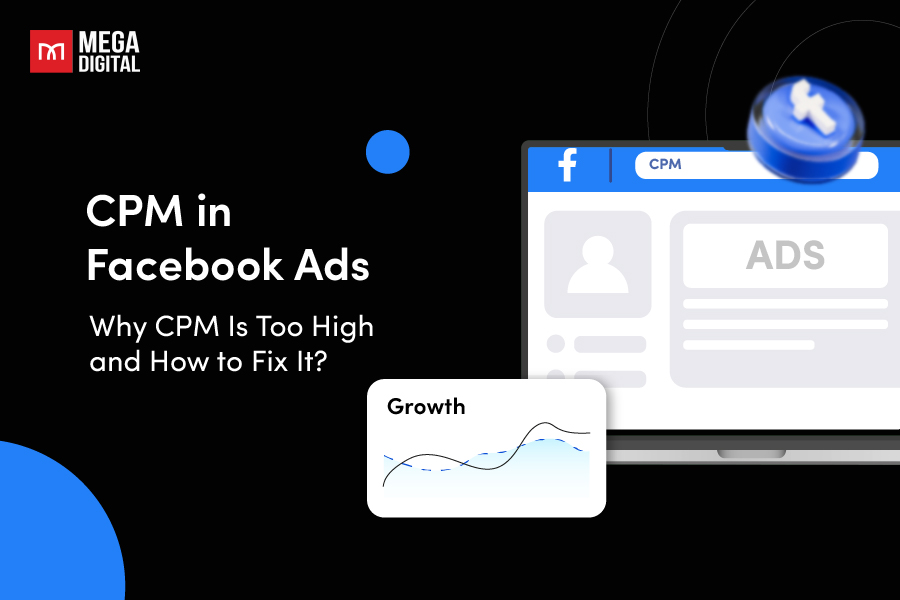As a business owner or marketer, you’ve likely heard of ROAS in the context of Google Ads. ROAS is one of many metrics you can use to measure the success of your ad campaigns. But what does it mean, and why is it important? In this article, I will explain the concept of ROAS and Target ROAS, and how to effectively set and measure it in your Google Ads campaigns.
What is ROAS?
To understand what exactly is Target ROAS, you first need to get a grasp of the metric called ROAS. ROAS, or Return on Ad Spend, is a key performance metric used in Google Ads to measure the effectiveness of online advertising campaigns. It calculates revenue generated for each dollar spent on advertising. ROAS can be assessed at various levels within Google Ads, including the account, campaign, ad group, and ad levels.
The formula for calculating ROAS is straightforward: divide the total conversion value by the total cost of your ad interactions.
For example, let’s say you run an online store selling shoes. You spend $1000 on a Google Ads campaign, and as a result of this campaign, you make sales worth $5000. Here’s how you would calculate your ROAS:
So the ROAS of your campaign will be $5000 divided by $1000, and the result will be 5.
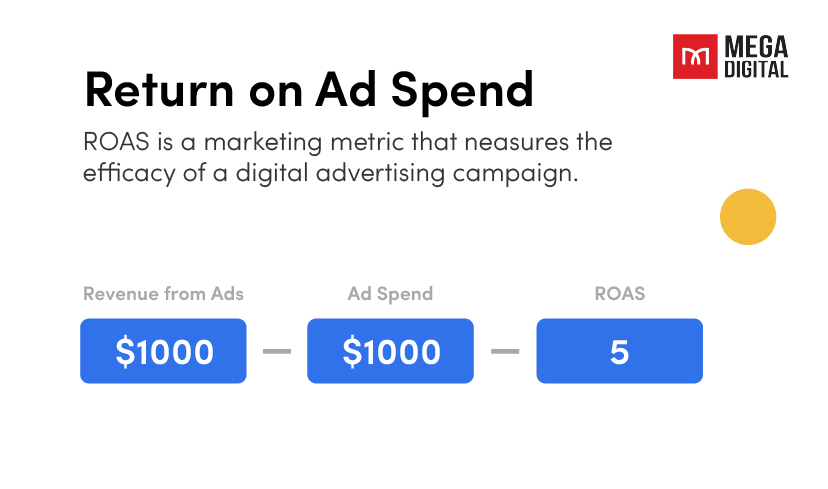
This means that for every dollar you spent on your Google Ads campaign, you earned $5 in revenue.
Target ROAS, or tROAS, is one of the Smart Bidding strategies that fall under the category of Google Ads’ automated bidding strategies. Target ROAS uses “auction-time bidding” powered by AI and machine learning to manage bids on behalf of advertisers. This means that Google will automatically target an optimal level of return on the money you spend on ads, optimizing campaigns for either conversions or conversion value.
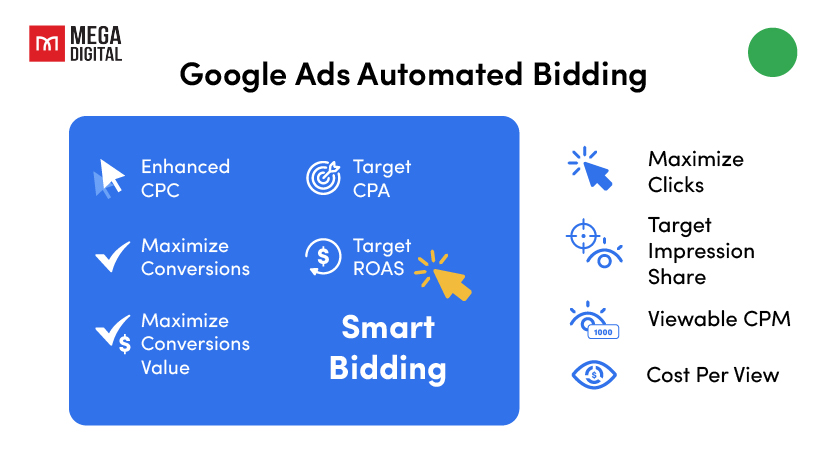
What is a Good ROAS for Google Ads?
When it comes to determining a “good” Return on Ad Spend (ROAS) for Google Ads, there isn’t a one-size-fits-all answer. The ideal ROAS can vary greatly depending on a variety of factors, including your industry, business model, and overall marketing goals.
In general, a ROAS of 4:1, meaning you earn $4 for every $1 spent on advertising, is often considered a benchmark for success. This ratio indicates that your advertising efforts are profitable, as you earn more than you spend.
On the other hand, for some businesses of other industries, an ROAS of 3:1 might be considered excellent, while others might aim for an ROAS of 5:1 or higher.
Learn more: Google Ads Benchmarks by Industry [Original & Latest data]
Factors that Influence ROAS
Several factors can influence what a good ROAS is for your specific business:
- Industry: Different industries have different average ROAS. For example, the average ROAS might be higher in luxury retail compared to fast-moving consumer goods (FMCG).
- Business model: Your business model can also impact what a good ROAS is. For instance, subscription-based businesses might be willing to accept a lower ROAS initially, knowing that customer lifetime value (CLV) is high.
- Profit margins: Your profit margins play a crucial role in determining a good ROAS. If your margins are thin, you’ll need a higher ROAS to ensure profitability.
- Overall goals: Your overall marketing and business goals will also influence your target ROAS. If you’re focused on growth and willing to invest heavily in customer acquisition, you might accept a lower ROAS.
Benefits of using target ROAS

Maximizes conversion value
The primary benefit of using the tROAS strategy is that it’s designed to maximize your conversion value based on the target ROAS you set. This means it aims to get you the most revenue possible for each dollar you spend on advertising.
Automates bid adjustments
With the tROAS strategy, Google’s algorithms automatically adjust your bids in real-time to maximize your conversion value. This takes the guesswork out of bid management and can save you significant time and effort.
Provides granular control
The tROAS strategy allows you to set different ROAS targets for different campaigns, ad groups, or even individual keywords. This gives you granular control over your ad spend and allows you to optimize different parts of your account based on their specific performance and goals.
Incorporates advanced machine learning
Google’s tROAS strategy leverages advanced machine learning algorithms to make accurate predictions and optimizations. These algorithms take into account a wide range of signals, including device, location, time of day, and more, to optimize your bids for each auction.
Aligns with business goals
By allowing you to set a target ROAS, this strategy ensures that your Google Ads campaigns are aligned with your overall business goals. Whether you’re looking to maximize revenue, increase profitability, or achieve another financial goal, the tROAS strategy can help you get there.
When to use Target ROAS strategy?
You should only use tROAS if:
- You have specific revenue goals: If you know how much revenue you want to generate for each dollar spent on advertising, the Target ROAS strategy can help you achieve this goal.
- You have enough conversion data: Google recommends that you have at least 15 conversions in the last 30 days before using the Target ROAS strategy. This ensures that Google’s algorithms have enough data to make accurate predictions and optimizations.
- Your conversion values are accurately tracked: The effectiveness of the Target ROAS strategy depends on accurate conversion tracking. If your conversion values are not accurately tracked, the strategy may not work as expected.
Who should use Target ROAS strategy?
The Target ROAS strategy can be a powerful tool for maximizing the return on your ad spend. However, it’s not for every advertiser. It’s important to understand that this strategy is only suitable for:
- E-commerce businesses: For businesses that sell products online, the Target ROAS strategy can help maximize revenue from ad spend.
- Advertisers with clear revenue goals: If you know exactly how much revenue you want to generate from your ad spend, the Target ROAS strategy can help you reach your goals.
- Experienced advertisers: The Target ROAS strategy requires a good understanding of Google Ads and conversion tracking. It’s best suited for advertisers who are comfortable with these concepts and have the time to monitor and adjust their campaigns as necessary.
How to Set Target ROAS in Google Ads?
Setting your target Return on Ad Spend (ROAS) in Google Ads is a critical step in optimizing your ad campaigns for profitability. Here’s a comprehensive guide on how to do it:
Step 1: Set up a value for your conversions
Start by logging into your Google Ads account. This will bring you to the main dashboard, where you can see an overview of your campaigns.
Click on ‘Tools and Settings’. Under ‘Measurement’, select ‘Conversions’ and you will be navigated to that section.
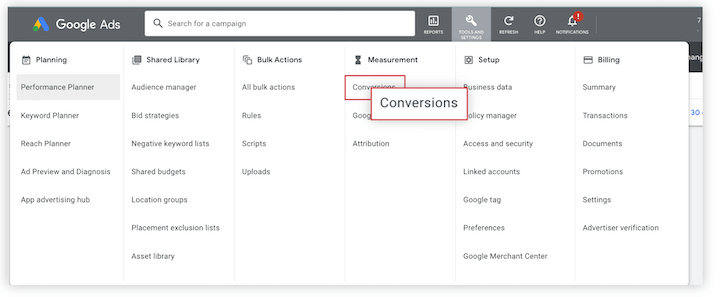
Next, select the main conversion action to which you want to assign a value. You’ll then have two choices:
- Use the same value for each conversion: Select this if you want to assign the same value for every conversion. This is typically used when each lead or purchase holds the same value to your business.
- Use different values for each conversion: This option is commonly chosen in e-commerce settings where different products have varying costs, and hence, do not contribute the same conversion value.
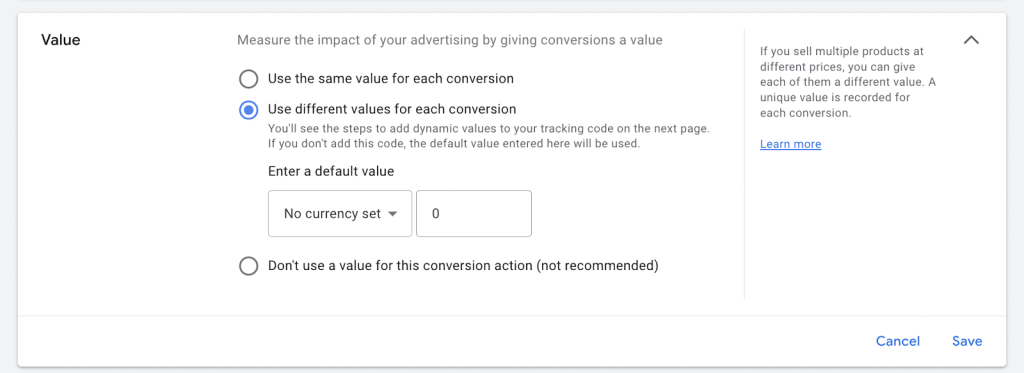
Step 2: Select the campaign
From the dashboard, select the campaign you want to apply a target ROAS to.
Once you’ve selected the campaign, click on “Settings” in the left-hand menu. This will open a new page where you can adjust various parameters for your campaign.
Step 3: Choose the bidding strategy
In the “Settings” page, look for the “Bidding” section. Click on it, and a drop-down menu will appear. From this menu, choose “Target ROAS”.
Choose “Maximize Conversion Value” as your bidding strategy.
Enable “Set a target return on ad spend”.

Step 4: Enter your desired ROAS
After selecting “Target ROAS”, you’ll have to enter your desired ROAS percentage. This is where you input the return you aim to achieve for every dollar spent on advertising.
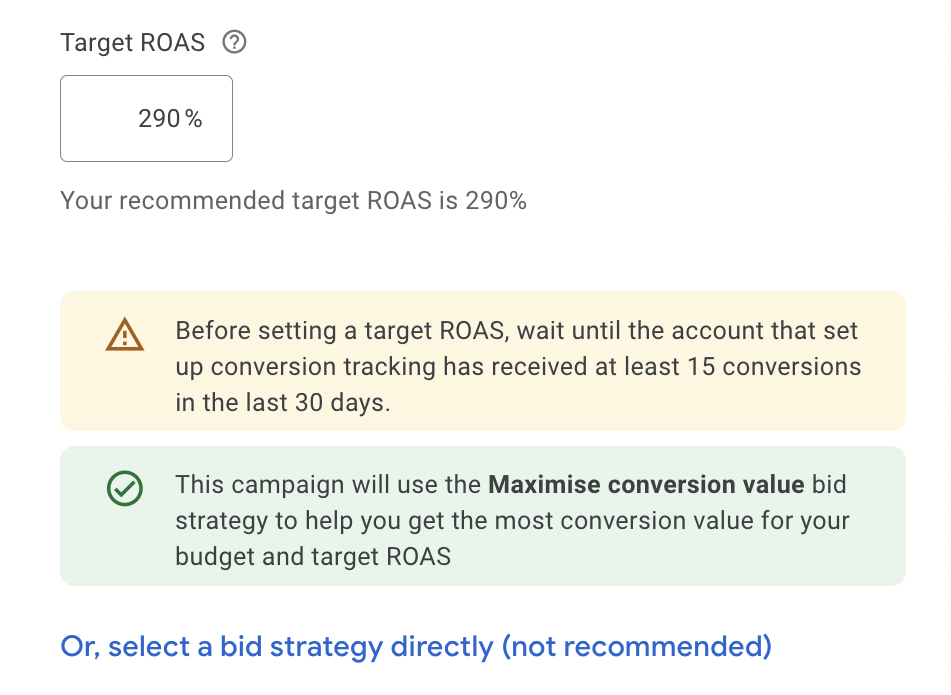
When determining this percentage, consider the following factors:
- The conversion value(s) you aim to optimize
- ROAS = (revenue/ad spend) * 100
- ROAS does not take into account everything that ROI does
Best Practices You Should Follow When Using Target ROAS Bidding Strategy
The Target Return on Ad Spend (ROAS) bidding strategy in Google Ads can be a powerful tool for maximizing your advertising ROI. However, to make the most of this strategy, it’s important to follow some best practices:
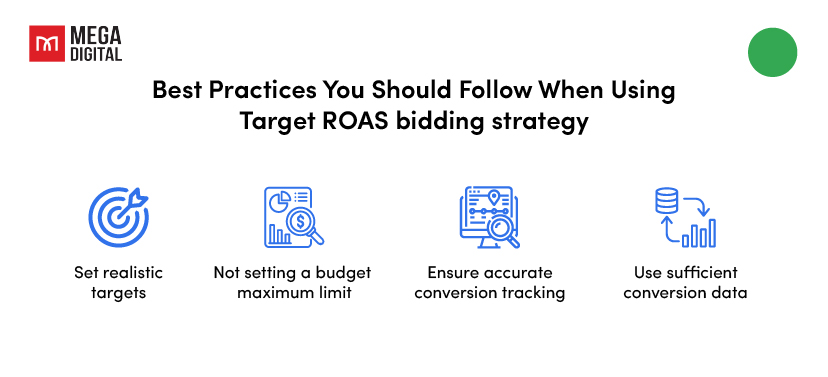
1. Set realistic targets
Your target ROAS should be realistic and achievable based on your past performance and industry benchmarks. A realistic target ROAS is crucial as it guides Google’s algorithms in optimizing your bids. Setting a target that’s too high could result in fewer conversions, as Google may not be able to find enough auction opportunities that meet your target.
For example, if you set a target ROAS of 10:1, Google’s algorithms will aim to get you $10 in revenue for every $1 you spend on ads. However, if such opportunities are scarce, your ads may not show as often as they could with a lower target, potentially leading to missed opportunities.
2. Not setting a budget maximum limit
This strategy relies on Google’s algorithms to find the most profitable opportunities for your ads within the constraints of your budget.
However, if you set a maximum limit on your budget, you may restrict the performance of the tROAS strategy. This is with a capped budget, the algorithms might run out of funds before they can exploit all the opportunities that could have generated a return above your target ROAS.
Therefore, not setting a maximum limit on the budget allows the tROAS strategy to perform to its full potential, maximizing your overall return on ad spend.
Of course, your budget funneled into the ad should be balanced with the overall financial constraints and goals of your business.
3. Ensure accurate conversion tracking
The effectiveness of the Target ROAS strategy depends on accurate conversion tracking. Make sure you’re tracking all relevant conversions and that your conversion values are accurate. This will allow Google’s algorithms to make accurate predictions and optimizations. If your conversion tracking is inaccurate or incomplete, Google’s algorithms won’t have the correct data to optimize your bids effectively.
For instance, if you’re not tracking all types of conversions (e.g., phone calls, form submissions, online sales), you might underestimate your true ROAS. Similarly, if your conversion values are inaccurate (e.g., all conversions are assigned the same value, regardless of the actual revenue they generate), your ROAS calculations could be skewed.
4. Use sufficient conversion data
Google’s algorithms rely on historical conversion data to make accurate predictions and optimizations. The platform recommends having at least 15 conversions in the past 30 days before using the Target ROAS strategy so that the algorithms have enough data to learn from and make accurate predictions. If you don’t have enough conversion data, the algorithms might not work as effectively.
Wrap-up
Understanding and effectively utilizing ROAS in Google Ads is crucial for maximizing the return on your advertising spend. By setting a target ROAS that aligns with your business goals, monitoring your campaigns closely, and making adjustments as necessary, you can drive significant growth for your business.








